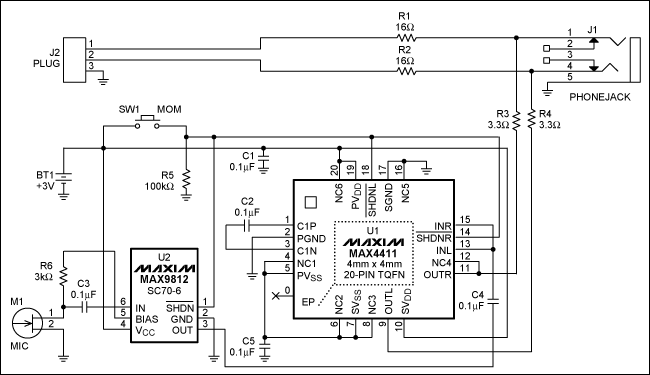

Headphone Attenuator Includes
音响技术
157人已加入
描述
Headphone Attenuator Includes Microphone Monitor(耳机麦克风衰减器带监控)
Abstract: This application note presents a circuit that reduces input amplitude and amplifies a microphone input. Designed for use with earbuds, the circuit enables clear sound for conversation even when the earbuds are used with low-cost, less-sensitive headphones. The MAX4411 headphone amplifier and MAX9821 microphone amplifier are featured.
|
Headphones that fit into the ear, sometimes called earbuds, provide excellent fidelity and some intrinsic cancellation of ambient background noise. Noise cancellation is useful on airplane flights and other situations where the user wants to concentrate or sleep. Cancelling that noise also makes verbal communication difficult. Muting the music source provides some help, but the earbuds can still interfere with conversation.
The minimum volume setting of an audio source is also sometimes an issue. The headphone outputs of a modern airliner, for example, are optimized for use with inexpensive disposable headphones. The sensitivity of low-cost headphones (i.e., the output sound pressure level, SPL, for a given power input) is lower than that of better-quality headphones. Consequently, using high-quality headphones and setting the control console for minimum volume can yield audio that is too loud to tolerate.
Fortunately, both of these problems are solved with a single circuit (Figure 1). R1 and R2 reduce the input amplitude. The other circuitry amplifies the microphone input and injects that amplified signal into the left and right headphone-signal paths, thus producing an audible feedback when you speak.

Figure 1. This headphone attenuator/amplifier has a microphone monitor and allows easy conversation while wearing earbuds.
Both the headphone amplifier (U1, the MAX4411) and microphone amplifier (U2, the MAX9812) connect directly to a 3V battery. During normal operation both devices are in shutdown, drawing mere microamperes from the battery. To speak with someone, you need only depress the momentary switch, SW1, to activate the microphone. That action enables the microphone amplifier's bias output which allows it to amplify the external sound. The headphone amplifier connects to this amplified sound and injects it into the headphone audio with resistors R3 and R4. As an added benefit of this mixing, the headphone amplifier's low-output impedance (when enabled) further attenuates the original audio stream.
The monitor circuit's sensitivity is adjusted by changing the values of R3 and R4. The audio-input attenuation is adjusted by changing the values of R1 and R2. Microphone, headphone jack, momentary switch, battery, and other circuitry fit in an enclosure the size of a key fob, with a ~1m cable and headphone plug attached.
声明:本文内容及配图由入驻作者撰写或者入驻合作网站授权转载。文章观点仅代表作者本人,不代表电子发烧友网立场。文章及其配图仅供工程师学习之用,如有内容侵权或者其他违规问题,请联系本站处理。
举报投诉
- 相关推荐
- 热点推荐
- Monitor
-
如何使用TLV320AIC3110输出两路headphone?2024-09-30 515
-
如何更新Includes文件夹?2022-12-06 566
-
HMC985A-Die: GaAs MMIC VOLTAGE - VARIABLE ATTENUATOR, 20 - 50 GHz2021-02-04 618
-
ADH346S: Space DC to 8 GHz Voltage-Variable Attenuator Data Sheet2021-01-27 678
-
Switch Attenuator驱动程序配置指南2019-05-06 1159
-
基于RFSA3023下的75Ω VOLTAGE CONTROLLED ATTENUATOR2018-08-03 878
-
请问DSK6713能否在lineout和headphone两个输出通道实现不同信号的输出?2018-08-01 1596
-
Complete Tutorial (Includes Sc2009-12-29 1704
-
便携式耳机放大器 (Portable Headphone A2009-12-24 2347
-
USB Power Solution Includes Sw2009-09-30 535
-
Ahammer headphone amplifier_pr2007-09-29 2787
全部0条评论

快来发表一下你的评论吧 !

